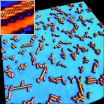(Press-News.org) Before they reach young adulthood, most children in the United States will experience their parents separating, divorcing, finding another partner, or getting remarried.
Research tells us that children have more behavior problems (such as aggression and defiance) when families change structure. Now a new study has found that behavior problems in children increased in families in which parents separated only in higher-income families, and that children's age also played a part in their likelihood of having behavior problems.
The study, by researchers at Georgetown University and the University of Chicago, appears in the journal Child Development.
The study also found that moving from a single-parent family into a stepparent family improved children's behavior in higher-income families but not in lower-income families.
"Our findings suggest that family changes affect children's behavior in higher-income families more than children's behavior in lower-income families—for better and for worse," notes Rebecca M. Ryan, assistant professor of psychology at Georgetown University, who led the study.
The study examined how different kinds of family changes related to children's behavior problems between ages 3 and 12 using a national sample of nearly 4,000 children (the Children of the National Longitudinal Survey of Youth). Children were divided into three groups: those in families living under 200% of the federal poverty line (FPL), those living between 200% and 300% of the FPL, and those living above 300% of the FPL around the time of the child's birth. (Income levels in these groups vary by family size and year, but in 2013, a family of four living under 200% of the FPL would earn about $47,100 or less, a family of four living between 200% and 300% of the FPL would earn between $47,100 and $70,650, and a family of four living above 300% of the FPL would earn more than $70,650.)
The study also compared the effects of parents' separation and remarriage or repartnering on children's behavior problems when children were 5 years old or younger versus when they were 6 to 12 years old.
While changes in family structure affected the behavior of children from high-income families, they didn't affect the behavior of children in low-income families. This may be because families with few economic resources at the outset may not experience as dramatic a change in economic circumstance when parents separate as those with greater initial resources, the researchers suggest.
Moreover, single-parent and blended families occur more often among lower-income families; in this context, single-parent and repartnered families may be perceived differently.
For children from high-income families, the researchers found that the effects of family change varied by age. Parents' separation increased the likelihood that children would have behavior problems only if the separation took place when the children were 5 or younger. However, moving into a stepparent family benefited children's behavior only when it occurred after age 6.
"These findings suggest that both economic context and children's age are important to consider in understanding the effects of family structure on children," notes Ryan. "While economic resources in many ways buffer children, higher initial family income doesn't appear to be a protective factor when parents separate, at least for younger children."
INFORMATION:
The study was funded by the University of Wisconsin's Institute for Research on Poverty.
Summarized from Child Development, Associations Between Family Structure Change and Child Behavior Problems: The Moderating Effect of Family Income by Ryan, RM (Georgetown University), Claessens, A (University of Chicago), and Markowitz, AJ (Georgetown University). Copyright 2014 The Society for Research in Child Development, Inc. All rights reserved.
Parents' separation found to boost children's behavior problems, but only in high-income families
2014-09-10
ELSE PRESS RELEASES FROM THIS DATE:
Mothers' responses to babies' crying: Benefiting from and getting over childhood experiences
2014-09-10
Research has told us that infants whose mothers respond quickly, consistently, and warmly when they cry have healthier emotional development than infants whose mothers are less sensitive to their cries. A new study has found that mothers whose childhood experiences with caregivers was positive and those who have come to terms with negative experiences are more infant-oriented when they see videos of babies crying and respond more sensitively to their own babies' cries.
The study, by researchers at the University of North Carolina at Greensboro, with input from colleagues ...
When talking about body size, African-American women and doctors may be speaking different languages
2014-09-10
PHILADELPHIA, PA, September 10, 2014 – African American women and their female children have the highest obesity prevalence of any demographic group and are more likely to underestimate their body weight than white women. Yet, according to new research from Rush University Medical Center, cultural norms for body size may prevent awareness among many African American women about the potential health benefits they and others in their cultural group might achieve through weight loss.
Led by Elizabeth Lynch, PhD, this research recruited African American women in a low-income ...
Smartphones may aid in dietary self-monitoring
2014-09-10
PHILADELPHIA, PA, September 10, 2014 – Smartphones have seen wide adoption among Americans in recent years because of their ease of use and adaptability. With that in mind, researchers from Arizona State University examined how smartphone use affected weight loss goals and determined that smartphones may offer users an advantage over traditional methods when tracking diet data.
Roughly 83% of Americans now own a mobile phone and 45% own smartphones with Internet access. For this study, researchers recruited healthy, weight-stable adults and semirandomly divided them ...
Molecular self-assembly controls graphene-edge configuration
2014-09-10
Sendai, Japan – A research team headed by Prof. Patrick Han and Prof. Taro Hitosugi at the Advanced Institute of Materials Research (AIMR), Tohoku University discovered a new bottom-up fabrication method that produces defect-free graphene nanoribbons (GNRs) with periodic zigzag-edge regions. This method, which controls GNR growth direction and length distribution, is a stepping stone towards future graphene-device fabrication by self-assembly.
Graphene, with its low dimensionality, high stability, high strength, and high charge-carrier mobility, promises to be a revolutionary ...
Temple University researchers identify a new target for treating heart failure
2014-09-09
As a heart fails, losing its ability to squeeze blood through the circulatory system, the body releases a neurohormone that interferes with the heart's best chance to improve contractility, a team of Temple University School of Medicine researchers show in a study published September 9th in the American Heart Association journal, Circulation.
The discovery reveals a promising target for the treatment of end-stage heart failure, and raises intriguing questions about why a drug used to treat some forms of end-stage heart failure improves symptoms but fails to extend lives ...
UT Southwestern expert co-chairs national team to develop first comprehensive guidelines for management of sickle cell disease
2014-09-09
DALLAS – September 9, 2014– The National Heart, Lung, and Blood Institute (NHLBI) has released the first comprehensive, evidence-based guidelines for management of sickle cell disease from birth to end of life, based on recommendations developed by a nationwide team of experts co-chaired by a UT Southwestern Medical Center hematologist.
Appearing today in JAMA, the guidelines are intended for general use by pediatricians, physicians treating adults, hematologists, emergency room personnel, hospitalists, and other health care providers. The new management guidelines consist ...
Nearly 1 in 5 new nurses leave first job within a year, according to RN survey
2014-09-09
Turnover of registered nurses (RNs) is an important and widely used measure in analyzing the health care workforce. It's used to project the job market for nurses (based on availability of jobs) and can also be considered an indicator of whether a health care organization has a good working environment.
A study in the current issue of Policy, Politics & Nursing Practice reveals that an estimated 17.5 percent of newly-licensed RNs leave their first nursing job within the first year and one in three (33.5%) leave within two years. The researchers found that turnover for ...
Less effective DNA repair process takes over as mice age
2014-09-09
As we and other vertebrates age, our DNA accumulates mutations and becomes rearranged, which may result in a variety of age-related illnesses, including cancers. Biologists Vera Gorbunova and Andei Seluanov have now discovered one reason for the increasing DNA damage: the primary repair process begins to fail with increasing age and is replaced by one that is less accurate.
The findings have been published in the journal PLOS Genetics.
"Scientists have had limited tools to accurately study how DNA repair changes with age," said Gorbunova. "We are now able to measure ...
Discovery paves the way for a new generation of chemotherapies
2014-09-09
A new mechanism to inhibit proteasomes, protein complexes that are a target for cancer therapy, is the topic of an article published in the journal Chemistry & Biology. The first author of the study is Daniela Trivella, researcher at the Brazilian Biosciences National Laboratory at the Brazilian Center for Research in Energy and Materials (LNBio/CNPEM).
The findings of the study, conducted with FAPESP support in partnership with researchers from the University of California in San Diego, United States, and at the Technische Universität München, in Germany, are paving the ...
Two-dimensional electron liquids
2014-09-09
Truly two-dimensional objects are rare. Even a thin piece of paper is trillions of atoms thick. When physicists do succeed in producing 2D systems, quantum interactions can lead to new phenomena and Nobel prizes. Two examples: graphene---single-atom-thick sheets of carbon atoms---has unique mechanical, electrical, and optical properties; and two-dimensional electron gases (2DEG)---planar collections of electrons supported at the interface between certain semiconductors such as gallium arsenide---allow the observation of such emergent behaviors as the quantum Hall effect ...



